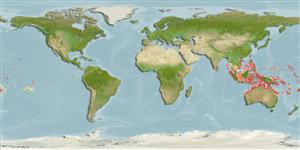Environment: milieu / climate zone / depth range / distribution range
экология
морской ассоциированный с рифами; пределы глубины 2 - 30 m (Ref. 27115), usually 3 - 30 m (Ref. 27115). Tropical; 22°C - 30°C (Ref. 27115); 19°N - 24°S
Western Pacific: from the western and eastern Australia to Tonga; north to Taiwan and the Philippines; throughout Indonesia, Papua New Guinea, Marshall Is., Solomons, and Fiji.
Size / Вес / Возраст
Maturity: Lm ? range ? - ? cm
Max length : 8.5 cm SL самец/пол неопределен; (Ref. 48637)
колючие лучи спинного плавника (общее число): 7; членистые (мягкие) лучи спинного плавника (общее число): 15-17; колючие лучи анального плавника 1; членистые (мягкие) лучи анального плавника: 15 - 17. This species is distinguished by the following characters: D VI + I,15-17 (first 2 dorsal-fin spines filiform, elongate, remaining progressively shorter); A I,15-17; pectoral-fin rays 16-18; united pelvic fins, frenum absent; rounded caudal fin; scale in series, longitudinal 55-61 and transverse 17-19; interorbital wide, 75-100 % of eye diameter; rear margin of upper jaw ending at vertical through anterior margin of eye or slightly behind; scales ctenoid posteriorly, becoming cycloid anteriorly between first dorsal fin and pectoral fin, at axil of pectoral fin, on nape and entire belly; predorsal scales 24-26; scales do not reach level of the posterior edge of the eye on predorsal area, ending at the level of pore G; naked cheek and opercle, in some specimens with a few cycloid scales in upper part; scales cover the basal 1/4-1/6 of the caudal fin, becoming rapidly smaller and cycloid; prepectoral area with about 5-9 vertical series of fine cycloid scales which cover the entire base of the pectoral fin; prepelvic area with cycloid scales, 11-16 in the midventral row (Ref. 119548). Colour of body charcoal grey with 5 dark-edged orange to reddish stripes; upper back with a row of white spots; yellow-edged black spot on second dorsal fin; upper caudal fin base with black spot (Ref. 90102).
Inhabits sandy and muddy bottoms of turbid coastal reefs (Ref. 1602) to depths pf 20m (Ref. 48637). Solitary or in small groups (Ref. 90102). Does not appear to use a burrow and seen in areas with coral growth (Ref. 1602).
Life cycle and mating behavior
половая зрелость | размножение | нерест | икра | Fecundity | личинки
Kovačić, M., S.V. Bogorodsky, A.O. Mal and T.J. Alpermann, 2018. Redescription of the genus Koumansetta (Teleostei: Gobiidae), with description of a new species from the Red Sea. Zootaxa 4459(3):453-481. (Ref. 119548)
Статус Красного Списка МСОП (Ref. 130435)
Угроза для людей
Harmless
Использование человеком
рыболовство: интереса не представляет; аквариум: коммерческий
дополнительная информация
народные названиясинонимыобмен веществхищникиэкотоксикологияразмножениеполовая зрелостьнерестSpawning aggregationFecundityикраРазвитие икры
ссылкиаквакультура (рыбоводство)особенности рыбоводствастепень растяжениягенетикаElectrophoresesнаследуемостьболезниобработкаNutrientsMass conversion
инструменты
Специальные отчеты
Скачать в формате XML
ресурсы в Интернет
Estimates based on models
Preferred temperature (Ref.
123201): 25.7 - 28.9, mean 27.8 °C (based on 574 cells).
Phylogenetic diversity index (Ref.
82804): PD
50 = 0.6250 [Uniqueness, from 0.5 = low to 2.0 = high].
Bayesian length-weight: a=0.00708 (0.00333 - 0.01504), b=3.09 (2.92 - 3.26), in cm total length, based on LWR estimates for this (Sub)family-body shape (Ref.
93245).
Trophic level (Ref.
69278): 3.3 ±0.4 se; based on size and trophs of closest relatives
устойчивость к внешним воздействиям (Ref.
120179): высокий, минимальное время удвоения популяции до 15 месяцев (Preliminary K or Fecundity.).
Fishing Vulnerability (Ref.
59153): Low vulnerability (10 of 100).
Nutrients (Ref.
124155): Calcium = 162 [70, 329] mg/100g; Iron = 0.871 [0.406, 1.764] mg/100g; Protein = 17.4 [15.4, 19.2] %; Omega3 = 0.083 [0.035, 0.168] g/100g; Selenium = 26.1 [11.6, 64.3] μg/100g; VitaminA = 113 [23, 528] μg/100g; Zinc = 2.69 [1.66, 4.15] mg/100g (wet weight);
